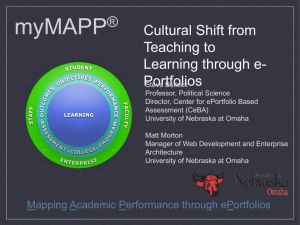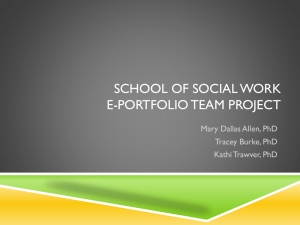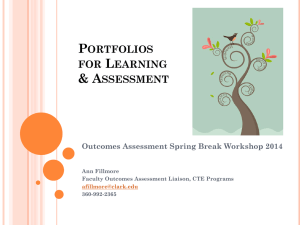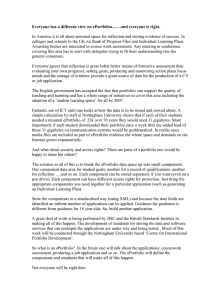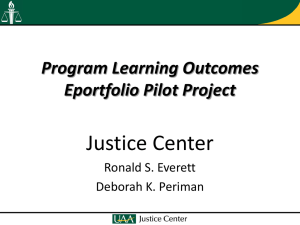Eastern Connecticut State University Strategic Plan Benchmark Proposal
advertisement
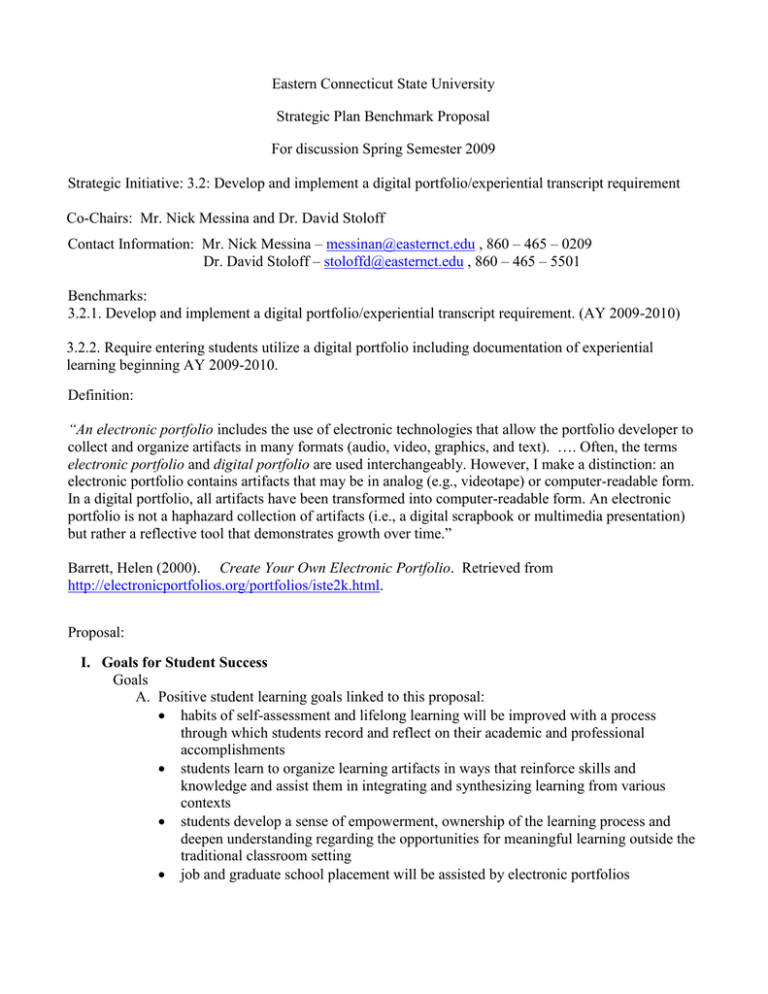
Eastern Connecticut State University Strategic Plan Benchmark Proposal For discussion Spring Semester 2009 Strategic Initiative: 3.2: Develop and implement a digital portfolio/experiential transcript requirement Co-Chairs: Mr. Nick Messina and Dr. David Stoloff Contact Information: Mr. Nick Messina – messinan@easternct.edu , 860 – 465 – 0209 Dr. David Stoloff – stoloffd@easternct.edu , 860 – 465 – 5501 Benchmarks: 3.2.1. Develop and implement a digital portfolio/experiential transcript requirement. (AY 2009-2010) 3.2.2. Require entering students utilize a digital portfolio including documentation of experiential learning beginning AY 2009-2010. Definition: “An electronic portfolio includes the use of electronic technologies that allow the portfolio developer to collect and organize artifacts in many formats (audio, video, graphics, and text). …. Often, the terms electronic portfolio and digital portfolio are used interchangeably. However, I make a distinction: an electronic portfolio contains artifacts that may be in analog (e.g., videotape) or computer-readable form. In a digital portfolio, all artifacts have been transformed into computer-readable form. An electronic portfolio is not a haphazard collection of artifacts (i.e., a digital scrapbook or multimedia presentation) but rather a reflective tool that demonstrates growth over time.” Barrett, Helen (2000). Create Your Own Electronic Portfolio. Retrieved from http://electronicportfolios.org/portfolios/iste2k.html. Proposal: I. Goals for Student Success Goals A. Positive student learning goals linked to this proposal: habits of self-assessment and lifelong learning will be improved with a process through which students record and reflect on their academic and professional accomplishments students learn to organize learning artifacts in ways that reinforce skills and knowledge and assist them in integrating and synthesizing learning from various contexts students develop a sense of empowerment, ownership of the learning process and deepen understanding regarding the opportunities for meaningful learning outside the traditional classroom setting job and graduate school placement will be assisted by electronic portfolios B. Objectives related to these goals: Students will demonstrate the skills of a reflective learner by identifying personal strengths and challenges, assessment of learning and setting goals for the future Students will document the full range of his or her learning experiences (including experiential learning) in a comprehensive and reflective way II. Implementation Plan A. Method 1. Needs and Interest Assessment A survey of faculty conducted by the implementation committee during fall 2008 suggested modest agreement with a wide range of primary purposes of an electronic portfolio requirement for all students (see results in Appendix A). The majority of the respondents (N=41) thought Eastern’s ePortfolio system should be … Percent – strongly agree or agree 92% 88% 71% 71% 71% 63% 61% 61% 61% 58% 54% Survey item Easy of use, easy to learn Ability to support large files A common format that is easy to learn, teach, and use Ability to create specific views of the ePortfolios for specific audiences An employment tool for graduates Longevity of the accounts – beyond the end of each semester Ability to generate individual and group qualitative and quantitative information A reflective tool for students A student assessment tool Integration with other educational technology at Eastern A program assessment tool There was less agreement with the ePortfolios being a course assessment tool (46% in agreement), a university assessment tool (37% in agreement), a graduation requirement (37%), or a resource for alumni (27%). 2. E-Portfolio as a Graduation Requirement: A Gradual Approach As in all initiatives in educational technology, this infusion of ePortfolios at Eastern CSU will be a dynamic process. The e-portfolio at Eastern will be a student-centered learning tool that may be incorporated into various learning environments, such as major or minor programs, core curriculum or co-curricular experiences. Dr. Helen Barrett, who was a guest speaker at Eastern on April 2, thanks to the support of Vice President Rhona Free and the Center for Educational Excellence, described the various purposes and uses of electronic portfolios and outlines stages of concern for the implementation of electronic portfolios (see Appendix B); she agreed for us to videotape her presentations. Following our discussions with Dr. Barrett, we expect that the first phase of implementation of 2 electronic portfolios at Eastern will begin with students documenting their learning and evolving with some programs and departments employing these student materials to assess and document achievement. Dr. Barrett’s videos are now featured on the Eastern Television website: http://nutmeg.easternct.edu/easterntelevision/teachingexcellenceseminar.htm Dr. Helen Barrett describes the process of assimilation of e-portfolios into academic cultures. We expect that the process of infusion at Eastern will follow this pattern. “Stages of Concern 1. Awareness/Information concerns (they don't know anything about e-portfolios and they need lots of information and a vision) 2. Personal concerns (they know about e-portfolios but have no experience with them, either personally or with their students) 3. Management concerns (they have some personal experience with e-portfolios but aren't sure how to manage a classroom full of students developing them) 4. Consequence concerns (their students are started developing e-portfolios and they want to do the best job of using the portfolios for improving student learning 5. Collaboration concerns (their students are well along in the process, and they want to collaborate with other colleagues about using e-portfolios 6. Refocusing concerns (they see real evidence of student achievement, and they want to do something better)” Barrett, H. (2005). Professional Development Guide. Retrieved from http://electronicportfolios.org/teachers/profdev.html . Based upon Barrett’s framework for the movement from awareness to refocusing, the application of electronic portfolios is slowly gaining faculty and university acceptance, moving from awareness/information to personal and management concerns. The consensus has moved towards an initial emphasis on students developing and assessing their own electronic portfolios and the need for departmental and programmatic flexibility in the uses of ePortfolios for assessment. Several strategic initiatives reference the use of electronic portfolios and suggest that they should be incorporated into their implementation plans. These include Liberal Arts Work!, Global Citizenship Program, the Center for Community Engagement, the First Year Program and the Liberal Arts Core Curriculum. See Appendix C for the description of how each of these initiatives plan to integrate electronic portfolios into their programs. The Education Department and the School of Continuing Education currently employ electronic portfolios with their students. A number of departments have indicated an interest in exploring and piloting an e-portfolio system for one or more of their courses. These include English and Social Work. Faculty members in the Environmental Earth Science Department discussed this initiative and their department chair asked that this statement be included: - “If a department wishes to 3 incorporate the digital portfolio into a course the department retains the ability to determine the most appropriate course." The implementation of the use of electronic portfolios at Eastern will be a phased process which will begin with further technical exploration, faculty development, departmental discussions on the integration of electronic portfolios in meaningful ways within the curriculum, support for pilots and infusion, and ongoing assessment of this process. 3. Initial Technical Approach – some options: a. Explore ways of using each student’s “Z drive” to develop an ePortfolio. b. Provide a beginning generic e-portfolio template and instructions to all incoming first year students on a flash drive. c. Explore ways of using available software like PowerPoint or One Note for students to develop portfolios that are stored on flash drives. d. Explore ways to make use of Blackboard VISTA and/or future course management systems, used for online courses at Eastern, as ongoing ePortfolio platforms. e. Explore the uses of free or low-cost ePortfolio software, like Google Sites, to develop scaffolding for an Eastern ePortfolio process that would be webaccessible. (A prototype Eastern ePortfolio site and a video on Eastern’s Liberal Education Electronic portfolio is available at http://sites.google.com/site/easterncsueportfolio/. A video developed by students in LAP 130 – Leading Edge Educational Technology, Spring 2009, “The Adventure of ePortfolio”, posted at http://www.youtube.com/watch?v=k5LJa-OV7pQ, illustrates student attitudes towards the potential of ePortfolios.) f. Explore ways of developing a process to pilot and assess other ePortfolio software, including LIVE@EDU or a future ePortfolio component within Blackboard. 4. Initial Infusion: Student Expectations and Support a. Convene a design team (see 6 below) that will continue to develop guidelines for electronic portfolios at Eastern. b. Expect that all incoming students develop and maintain an electronic portfolio and promote a culture that supports the infusion of electronic portfolios as a tool for documentation of student learning. c. Develop a module within the FYR 174 course, and the technology supports in CIT, on the creation and maintenance of an ePortfolio. d. Identify and support major programs that will be early adopters of an e-portfolio format. e. Encourage academic programs to explore using other technologies to draw together disparate information for the purposes of analyzing problems and reflecting upon solutions. f. Develop a teaching module that can be used to teach the practice of reflection on learning. This can be used by the First Year Program, LAP130 courses, Tier III LAC courses, Center for Community Engagement, major, minor and certificate programs and individual faculty. g. Encourage, but not require, that the documentation of the reflective component of the Tier III class be included in this e-portfolio. “TIER III affords students the opportunity to reflect on and apply knowledge and skills acquired in the first two 4 tiers and in their major” As part of this tier each student must: “Reflect on the context of their independent inquiry or artistic creation; and Reflect on this work as an outcome of their liberal arts education.” (Liberal Arts Core Curriculum, 2006, http://nutmeg.easternct.edu/lapc/LACC2006.htm ). 5. Faculty Development To fully implement an e-portfolio requirement will require faculty development through the Center for Educational Excellence, the support of FYR 174 faculty members and peer mentors, CIT and IT staff to provide support for the enhanced technology infrastructure, IT support for Requests for Proposal (RFP) or Request for Information (RFI) processes, assessment of prior experiences with ePortfolios and follow-up studies of student assessment of their own efficacy resulting from developing ePortfolios. 6. E-Portfolio Design Team A proposed design team, to be convened early in the Fall 2009 semester, would provide leadership in the next steps of this initiative. This group, composed of a representative of the Center for Educational Excellence, CIT, at least one faculty member or representative from each school, a representative of the engaged learning initiatives, the First Year Program and at least one student will be charged with the implementation, support and assessment of this initiative for a three-year period. Support will be provided through the Center for Educational Excellence. An annual report on progress will be submitted to the Vice President for Academic Affairs. 7. Assessment Student Learning E-portfolios may assist in assessing student learning by: Contributing to students’ abilities to reflect upon their learning as required in the Tier III capstone individual majors, minors and other elective or university-wide programs (such as the Writing Program, First Year Program, Liberal Arts Core Curriculum) may employ eportfolios to assess student learning providing opportunities for LAC Tier III faculty to assess the outcome of students’ liberal arts learning E-Portfolio Program Assessement The infusion of e-portfolios as a student requirement at Eastern will be assessed in process as detailed in the timeline. Assessment of the infusion approach will include tracking: # of faculty employing e-portfolios, # of majors with some e-portfolio usage, # of majors which require an e-portfolio in one or more courses, # of programs (including minors) which require or expect an e-portfolio, and # of students using an e-portfolio during this three-year period. 8. Critical Connections Opportunities, linkages and synergies 5 o Development of reflective competencies is necessary for community engagement and integrated learning o Global Citizenship and Global Scholars Programs will request that documentation of activities and reflection be contained in an e-portfolio. o Liberal Arts Work! may request that students seeking a non-credit internship experience document learning electronically in an e-portfolio. o The Writing Program may consider ways to use ePortfolios for writing assessment and to fulfill the writing requirement. o Changes in course management software, university intranet, e-mail and server systems may promote the use of e-portfolios. Challenges o Challenge of security o Challenges of professional development for students and faculty on ePortfolios. 9. Resources Personnel An individual, with affiliations with the Center for Educational Excellence, would be assigned up to 3 FLCS each semester for academic years 2009-2010 and 2010-2011, 2 FLCs for 2011-2012 and 2012-2013, and 1 FLC each semester for 2013-2014, to coordinate the infusion of ePortfolios into the first-year program curriculum, to present workshops for students, staff, and faculty on the ePortfolio applications within their areas of studies, to assist in organizing a process to select an ePortfolio platform that would be stable, secure, and cost-effective, and generate campus-wide support for these initiatives. The Center for Educational Excellence will be offering faculty development support for this ePortfolio initiative. Equipment Potential server space and the purchase of ePortfolio software may be necessary. More discussion with IT at Eastern and in the system office is needed. The potential software for ePortfolios is evolving quickly with the possibility of decisions being made within the next academic year. Supplies Some minimal support for flash drives for incoming students. Travel Travel support for individuals to participate and present on ePortfolios at the conferences of the Connecticut Educators Computer Association, EDUCAUSE, and other associations. 6 B. Implementation Timeline The timeline below will examine ways of introducing and infusing ePortfolios at Eastern. Semester/Session Goals Summer 2008 – Fall 2008 – Wintersession 2009 Spring 2009 Summer 2009 Fall 2009 Spring 2010 Summer 2010 Fall 2010 Spring 2011 Summer 2011 Fall 2011 Spring 2012 Summer 2012 Fall 2012 Spring 2013 Summer 2013 Develop consensus on the goals and methods of ePortfolio applications at Eastern Developing connections with other initiatives on campus – First-Year Program, Expanding Horizons, Liberal Arts Works!, Center for Community Engagement Plan for the implementation of ePortfolio introductions in FYR 174 courses. Plan for all students in the First Year Program in fall 2009 will have the opportunity to learn about e-portfolios and their benefits through FYR 174 courses or group meetings. Convene a design team from Media Services, CEE, CIT, representatives from engaged learning initiatives, representatives from the 3 Schools, and student representative(s). Two major departments and several Tier III courses will explore ePortfolio applications. Assess these projects and develop a timeline for first year students to develop experiential transcripts, introducing ePortfolio system to at least 20 FYR faculty and peer mentors Use ePortfolios in at least 20 FYR sections and 10 other courses, assessing the use of the new system ePortfolio usage within LAP colloquia and other courses – reaching at least 40 courses assessment of the first year of the selected ePortfolio system, recruiting all of the FYR faculty and peer mentors in developing ePortfolios use ePortfolios in all FYR sections and 20 other courses, Tier III courses ecourses, seeking Tier I and II usage ePortfolio usage within LAP colloquia and other courses – reaching at least 50 courses assessment of the second year of the selected ePortfolio system, recruiting all of the FYR 174 faculty and peer mentors in developing ePortfolios use ePortfolios in all FYR sections and 50 other courses, including Tier I, II, and III courses ePortfolio usage within LAP colloquia and other courses – reaching at least 100 courses, including Tier I, II, and III courses, presentations at Expo or A&S Exhibition of ePortfolios, institutionalization of ePortfolio system at Eastern, continual assessment and refinement, and showcasing exemplary models Progress Assessment Developing first draft template of Eastern’s Liberal Education ePortfolio Discussions with Chairs of each School and with Continuing Education, … Learning module created # of sections in which eportfolios introduced Development of general guidelines for ePortfolio goals and implementation. # of LAC Tier III section and # of uses in major programs Written qualitative feedback from faculty and students # of sections in which eportfolios introduced # of LAC sections and # of uses in major programs Written qualitative feedback from faculty and students # of sections in which eportfolios introduced # of LAC sections and # of uses in major programs Written qualitative feedback from faculty and students # of sections in which eportfolios introduced # of LAC sections and # of uses in major programs Written qualitative feedback from faculty and students 7 Assessment of Effectiveness 1. Provide a plan to assess achievement of objectives a. Measureable indicators relevant to each goal that specify the characteristics students should exhibit to demonstrate desired achievement Students will demonstrate the skills of a reflective learner by identifying personal strengths and challenges, assessment of learning and setting goals for the future. Portfolio usage and quality will be assessed as part of the ePortfolio assessment within programs, curricula, specific courses or majors. Students will document the full range of their learning experiences (including experiential learning) in a comprehensive and reflective way. b. Provide evidence of success of similar initiatives from existing literature/research Examples: ePortfolio committee members participated in an Adobe Connect conference on February 17, 2009 with Dr. Gail Ring, Director of the ePortfolio Program, at Clemson University. Their website, http://www.clemson.edu/ugs/eportfolio/index.html, provides links to exemplary student ePortfolios. Alverno College, a long-standing leader of the uses of portfolios in higher education, has developed the Alverno's Diagnostic Digital Portfolio (http://www.alverno.edu/academics/ddp.html) Dr. Helen Barrett’s website (http://electronicportfolios.org/ ) provides many examples of the uses of electronic portfolios in learning and teaching. Her visit to Eastern on Thursday, April 2 was videotaped and should be available for viewing soon. Dr. Barrett stresses that electronic portfolios are learning tools for students first in an illustration she gave permission to share in Appendix B. Anticipated Outcomes The proposed integration of ePortfolios into Eastern’s learning environment is consistent with the mission and values of Eastern as Connecticut’s Public Liberal Arts University. The institutionalization of an ePortfolio system at Eastern will assist students in developing skills in documenting their learning, accomplishments, and skills and making connections between the liberal arts coursework, major studies, and experiential learning in the Eastern community and beyond. Student ePortfolios will empower the learners by documenting their own experiences in social responsibility, community engagement, collaborative learning, inclusion, and academic excellence. E-Portfolios provide opportunities for students to work collaboratively and to develop creative approaches to document lifelong learning. 8 Annotated Bibliography Bailey, Mark (2002). Learning, Technology and Educational Transformation. Retrieved from http://education.ed.pacificu.edu/bcis/workshop/adoption.html, December 16, 2008. Barrett, Bob (2008). Creating E-Portfolio Programs as a Strategic Tool for Evaluation. Retrieved from http://www.ce.ucf.edu/asp/aln/cfp/presentations/1225870348229.ppt , December 16, 2008. Primary Purposes of E-Portfolios • Academic planning and advising (4%) • Student evaluation and grading (24%) • Career and resume planning (16%) • Reflection (36%) • Institutional Assessment/Program Evaluations (8%) • Faculty Evaluation and Tenure (4%) • Other (2%) • Not Available (6%) **Based upon the AAHE self-report survey of 51 Universities and Colleges (http://bearlink.berkeley.edu). Secondary Purposes of E-Portfolios** • Academic planning and advising (25%) • Student evaluation and grading (14%) • Career and resume planning (43%) • Reflection (29%) • Institutional Assessment/Program Evaluations (47%) • Faculty Evaluation and Tenure (5%) Barrett, Helen (2000). Create Your Own Electronic Portfolio. Retrieved from http://electronicportfolios.org/portfolios/iste2k.html. Barrett, Helen; Lewis, Tom; & Batson, Trent (2002). Panel II: A presentation on electronic portfolios at NLII meeting, October 25, 2002. Retrieved from http://net.educause.edu/ir/library/powerpoint/NLI0230a.pps, December 17, 2008. Ring, Gail; Weaver, Barbara; Jones, James H. Jr. (2008). Electronic Portfolios: Engaged Students Create Multimedia-Rich Artifacts. Journal of the Research Center for Educational Technology, Vol. 4, No. 2 (2008, Fall), retrieved at http://www.rcetj.org/?type=art&id=90071, January 15, 2009. 9 FAQ for Electronic Portfolio Initiative 2/8/09 What is the difference between a file with a collection of electronic documents and an electronic portfolio? “An electronic portfolio includes the use of electronic technologies that allow the portfolio developer to collect and organize artifacts in many formats (audio, video, graphics, and text). …. Often, the terms electronic portfolio and digital portfolio are used interchangeably. However, I make a distinction: an electronic portfolio contains artifacts that may be in analog (e.g., videotape) or computer-readable form. In a digital portfolio, all artifacts have been transformed into computer-readable form. An electronic portfolio is not a haphazard collection of artifacts (i.e., a digital scrapbook or multimedia presentation) but rather a reflective tool that demonstrates growth over time.” (Barrett, Helen (2000). Create Your Own Electronic Portfolio. Retrieved from http://electronicportfolios.org/portfolios/iste2k.html.) How will students learn about the electronic portfolio requirement at Eastern? It is proposed that developing ePortfolios would become a component of the FYR 174 seminar, a course that will be required for all incoming first year students in fall 2010. Who will construct the portfolio, oversee it, and assess it? Learners will construct their own portfolios, perhaps from templates provided during instruction within the FYR 174 courses or large group workshops. It is proposed that FYR 174 faculty members will do simple assessment of these initial ePortfolios as part of their seminar. ePortfolios might also be a tool for assessment within the Tier III seminars. Major and other programs may also require students to maintain an e-Portfolio. Why is this a student requirement? ePortfolios have been shown at Clemson University and Alverno College to be good assessment tools for learners as they reflect on their studies and for programs seeking exemplary student projects for accreditation purposes. Will there be a template that all students will use? There is a proposed template system being piloted during Spring 2009. The template would allow for departments and individual faculty members opportunities to add or revise for programmatic needs. The learners will be allowed flexibility to design their own websites as long as certain webpages – for example, a resumé, academic transcript, experiential transcript, reflection on the liberal arts program, and a collection of linked documents are included. How will Tier III courses employ the portfolio? It is proposed that Tier III course use ePortfolios as a way of fulfilling this goal – “TIER III affords students the opportunity to reflect on and apply knowledge and skills acquired in the first two tiers and in their major.” Why is reflection important? Reflection allows for practice in higher order thinking skills – evaluation and synthesis. 10 Won’t this requirement generate more work for faculty? Student development of ePortfolios might change the work of faculty. In an optimized form, there would no longer be the need to collect paper copies of assignments, students’ attention might be focused on past learning as a way to produce higher order thinking, and students might be more prepared for independent reflection and inquiry and undergraduate research projects. ePortfolios would catalyze changes in learning and teaching, not requiring more faculty effort, but changing the role and time commitment of the faculty member. How will double majors use the portfolio? ePortfolios might serve as a collection of documents from both majors. Assessment might be within Tier III or other major courses. Advisors who choose to review student ePortfolios will be better able to understand the whole student, his or her interests, values, strengths and challenges, and how he or she makes meaning from education and experiences. The advisor may be better able to support and encourage the student and assist in providing career and academic direction. 11 Appendix A Results of Faculty Digital Portfolio Survey – Fall 2008 Eastern's ePortfolio should serve as 5=strongly agree, 4=agree, 3=neither agree or disagree, 2=disagree, 1=strongly disagree 5 4 3 2 1 Response Total 34.15% (14) 26.83% (11) 24.39% (10) 9.76% (4) 4.88% (2) 41 43.9% (18) 26.83% (11) 14.63% (6) 4.88% (2) 9.76% (4) 41 A student assessment tool 26.83% (11) 34.15% (14) 26.83% (11) 7.32% (3) 4.88% (2) 41 A course assessment tool 17.07% (7) 29.27% (12) 34.15% (14) 4.88% (2) 14.63% (6) 41 A program assessment tool 14.63% (6) 39.02% (16) 26.83% (11) 12.2% (5) 7.32% (3) 41 An university assessment tool 14.63% (6) 21.95% (9) 39.02% (16) 14.63% (6) 9.76% (4) 41 A graduation requirement 17.07% (7) 19.51% (8) 26.83% (11) 14.63% (6) 21.95% (9) 41 A resource for alumni 14.63% (6) 12.2% (5) 46.34% (19) 7.32% (3) 19.51% (8) 41 A reflective tool for students An employment tool for graduates Total Respondents 41 11. WANTS 5 4 3 2 1 Response Total A common format that is easy to learn, teach, and use 56.1% (23) 14.63% (6) 21.95% (9) 0% (0) 7.32% (3) 41 Integration with other educational technology at Eastern – VISTA, Banner, student accounts, … 41.46% (17) 17.07% (7) 21.95% (9) 7.32% (3) 12.2% (5) 41 43.9% (18) 19.51% (8) 19.51% (8) 7.32% (3) 9.76% (4) 41 Longevity of the accounts – beyond the end of each semester, as outreach to alumni, … Ability to support large files – videos, 70.73% (29) graphics, audio files, … 17.07% (7) 2.44% (1) 2.44% (1) 7.32% (3) 41 Ease of use, easy to learn - short learning curve, with advanced 73.17% (30) features to be learned as one become more comfortable with platform, 19.51% (8) 2.44% (1) 0% (0) 4.88% (2) 41 Ability to create specific views of the ePortfolios for specific audiences, 31.71% (13) 39.02% (16) 14.63% (6) 4.88% (2) 9.76% (4) 41 Ability to generate individual and group qualitative and quantitative information, 29.27% (12) 31.71% (13) 21.95% (9) 4.88% (2) 12.2% (5) 41 Should be a requirement for graduation for the class of 2013. 7.32% (3) 14.63% (6) 43.9% (18) 12.2% (5) 21.95% (9) 41 Total Respondents 41 12 Appendix B – Balancing the Two Faces of ePortfolios – Dr. Helen Barrett’s model ©2009, Helen C. Barrett, Ph.D. - http://electronicportfolios.org/balance/index.html updated April 16, 2009 Stages of Faculty Acceptance of Electronic Portfolios “Stages of Concern 1. Awareness/Information concerns (they don't know anything about e-portfolios and they need lots of information and a vision) 2. Personal concerns (they know about e-portfolios but have no experience with them, either personally or with their students) 3. Management concerns (they have some personal experience with e-portfolios but aren't sure how to manage a classroom full of students developing them) 4. Consequence concerns (their students are started developing e-portfolios and they want to do the best job of using the portfolios for improving student learning 5. Collaboration concerns (their students are well along in the process, and they want to collaborate with other colleagues about using e-portfolios 6. Refocusing concerns (they see real evidence of student achievement, and they want to do something better)” Barrett, H. (2005). Professional Development Guide. Retrieved from http://electronicportfolios.org/teachers/profdev.html . 13 Appendix C – Connections to other strategic initiatives In their strategic planning document, the Liberal Arts Work! Design committee (Benchmark Number: 1.4.1, 1.4.2, 1.4.3) wrote that students would have the responsibility in the fourth year of their studies to reflect on their studies using ePortfolios. The committee proposal also mentioned under technology resources needed for their initiative that “[ePortfolio] if electronic portfolios are the preferred method for the LAW committee for dealing with non-credit bearing experiences.” The committee members also envisioned the needed service of a technology specialist as an ePortfolio liaison. http://nutmeg.easternct.edu/strategicplanning/Implementation/pdfs/Benchmark-1_4.pdf The committee members who developed the STRATEGIC INITIATIVE 1.3 - CENTER FOR COMMUNITY ENGAGEMENT plan wrote that the center will “explore the development of an engagement notation on student transcript and/or through experiential portfolio process,” “use experiential portfolios to document experiences and students’ personal growth,” and “evaluate eportfolios” to assess program goals. http://nutmeg.easternct.edu/strategicplanning/Implementation/pdfs/Strategic-Initiative_13_Proposal.pdf The STRATEGIC INITIATIVE 1.2 – GLOBAL CITIZENSHIP INITIATIVE (FKA EXPANDING HORIZONS) committee members wrote that “recommends the adoption of a variety of tracking methods, e-Portfolios, and assessment of students in First-Year program clusters and Liberal Arts colloquia.” The committee members also added that in academic year 2009-2010 that the Director and Council (of the Global Citizenship program) “work with the ePortfolio initiative to establish procedures for using e-Portfolios for reporting and assessment at all levels.” Some of this initiative’s program assessment strategies would include the “random sampling of students’ e-Portfolios for documentation of event attendance,” “reports and reflective essay(s) to included in an e-Portfolio to be monitored by a faculty mentor and randomly sampled for program assessment,” and “project report and reflection in e-Portfolio approved by faculty member and a second reader from the Global Citizenship program committee.” The proposal also indicates that the “American Council on Education has an extensive section on its site devoted to assessment of learning outcomes. Six institutions were involved in a three-year assessment project using a student survey/e-portfolio approach http://www.acenet.edu/Content/NavigationMenu/ProgramsServices/cii/res/assess/index.htm .” This Global Citizenship Initiative is posted at http://nutmeg.easternct.edu/strategicplanning/Implementation/pdfs/Strategic_Plan_Benchmark_1 -2.pdf . In the strategic planning document for the Liberal Arts Program, committee members wrote that “The Liberal Arts Core curriculum states that “Basic computer literacy skills are expected of all entering students. Students will engage in a computer-assisted selfassessment of skills. Students who need remediation in these areas may engage in online, self-guided training, non-credit workshops, or other activities to meet the basic competency within their first 30 academic credits.” A self-assessment survey has been given to entering first year students during the past two years. Students’ scores are calculated and students who score at one standard deviation below the mean are provided with information about on-line resources to develop the necessary 14 competencies. For those who score two or more standard deviations below the mean, students are invited to attend workshops provided by ITS in addition to providing them information about on-line resources. This process has been labor intensive and does not reach 100% of entering students. This assessment is also an indirect measure of students’ capabilities. It may be possible to integrate this proficiency assessment with emerging ideas about the use of an electronic portfolio, another strategic plan initiative. The First Year Program Committee has endorsed a module in the FYR 174 course that will include introduction to an electronic portfolio. Students may learn the use of these portfolios through this course or in workshops offered by ITS through the ASC. Preliminary plans include the possibility that students could be given an electronic portfolio template on a thumb drive, and each student will use the portfolio to document their learning. The use of the portfolios, that may be adopted by major programs, would be direct evidence of students’ technological proficiencies within their first year of study at Eastern.” This committee also noted the Liberal Arts program is linked to an ePortfolio initiative. “The Electronic Portfolio initiative may provide a template of LAC learning outcomes and encourage students to document their learning in each of these categories. In addition, the evidence of learning that students document in their electronic portfolios will be useful in their Tier III LAC capstone course in which they all must reflect on their liberal education. This may provide a vehicle for direct evidence of students’ technological proficiencies during their first 30 credits of study.” “Resources related to the electronic portfolio initiative will be included within that proposal. Laboratory Costs: Each additional lab section will require a budget of approximately $200 for expendable and non-expendable supplies and equipment.” On March 2009, the First Year Program Committee supported a motion that “FYR 174 faculty consider the possibility of using e-portfolio in their FYR 174 classes.” The Strategic Plan for the First Year Program also includes – “Strategic Initiative 3.2 calls for the development and implementation of a digital portfolio/experiential transcript requirement. In fact, the FYP Committee voted to ask faculty teaching in the FYP this fall, on a voluntary basis, to train their students in the use of electronic portfolios. A digital portfolio containing a student’s progressive academic work during their first college year (and beyond of course) could be used in assessing academic skills development.” http://nutmeg.easternct.edu/strategicplanning/Implementation/pdfs/Benchmark_1_1.pdf 15
